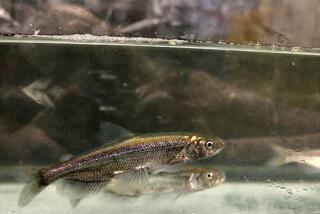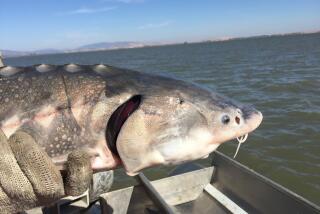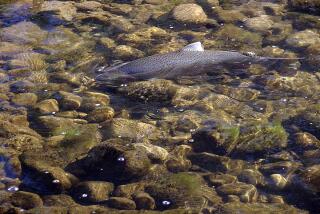Green Sturgeon Denied Protected Status
- Share via
The Bush administration on Thursday declined to grant the green sturgeon protection as an endangered species, despite signs that the enormous fish native to Northern California and Pacific Northwest rivers since the dinosaur’s Jurassic period may be on the way out.
The decision was the latest in a series of refusals by the administration to add rare marine mammals or oceanic fish to the list of animals protected by the Endangered Species Act. Other rejected species have been the rockfish bocaccio, the white marlin, a type of killer whale, and 18 fish found in the Puget Sound.
In rejecting the green sturgeon, the National Marine Fisheries Service found insufficient evidence to show imminent danger to two distinct populations of the bottom-feeding fish.
“Based on a review of the best available data,” said assistant administrator Bill Hogarth, “neither appears to be declining in population numbers or is in danger of extinction.”
The agency will continue to monitor the well-being of the green sturgeon, Hogarth said, and keep it on its list of candidates as a possible addition to the endangered species list.
The rejection was immediately criticized by a coalition of environmental groups that had petitioned to protect the fish as a way to help preserve the sturgeon’s river spawning grounds.
Listing the sturgeon could have led to new limits on threats to the species’ survival, such as dams, water diverted for agriculture, and pollution washing from farms and logged lands.
“We know for a fact that two populations of green sturgeon, and possibly a third, have gone extinct in the past 20 years,” said Jeff Miller of the Center for Biological Diversity in Berkeley. “That’s a pretty good indication that the species is vulnerable.”
Miller said his nonprofit group, along with the Environmental Protection Information Center, WaterKeepers Northern California, and the Oregon Natural Resources Council, are likely to take their case to federal court.
Little is known about the olive green sturgeon, a lesser-known cousin of the white sturgeon, said Dan Erickson, a zoologist with the Wildlife Conservation Society who has been radio-tagging the fish for three years.
“The primary threat to the green sturgeon is a lack of information,” he said. “We don’t know if its abundance has gone up or down.”
The sluggish fish, which can grow to 7 1/2 feet long and 350 pounds, uses its shovel-like snout and a powerful mouth to vacuum up crayfish, crabs, clams and fish from the bottom of the ocean, bays and rivers.
The green sturgeon is not sought by commercial fishermen, but it ends up occasionally in the nets of fishermen trawling for salmon and then is thrown overboard as dead. Some American Indian tribes fish for the sturgeon for subsistence or ritual meals.
The slow-growing, long-lived sturgeon has a life-cycle similar in some ways to that of human beings. Females often don’t reproduce until well into their 20s, and the fish are known to live as long as 60 years or more.
The bony-plated, prehistoric-looking fish hasn’t changed much in 200 million years, scientists say. Capable of living in both fresh and salt water, the green sturgeon ranges from Alaska to Mexico, but mostly is found feeding in estuaries from San Francisco Bay to British Columbia. There are eight species of sturgeon in North America, four listed as threatened or endangered.
A panel of scientists convened by the government found two distinct populations of green sturgeon. One spawns in the Klamath/Trinity river basins and in Oregon’s Rogue River. The other spawns only in the Sacramento River.
Environmentalists sought to help the sturgeon by using the Endangered Species Act designation of “critical habitat” to make sure the fish have enough clean, cool water to spawn. All these rivers suffer from pollution and water diverted for farming, which was blamed for the massive die-off of salmon in the Klamath River last fall.
Zeke Grader, director of the Pacific Coast Federation of Fishermen’s Assn., said protection of the sturgeon would help the campaign to get federal officials to cut back on water for farms so fish can remain healthy and reproduce. “It just adds to our argument,” Grader said, “we’ve got to fix this river.”
More to Read
Sign up for Essential California
The most important California stories and recommendations in your inbox every morning.
You may occasionally receive promotional content from the Los Angeles Times.










